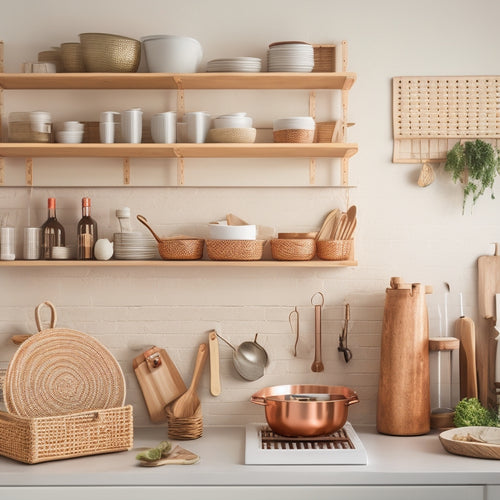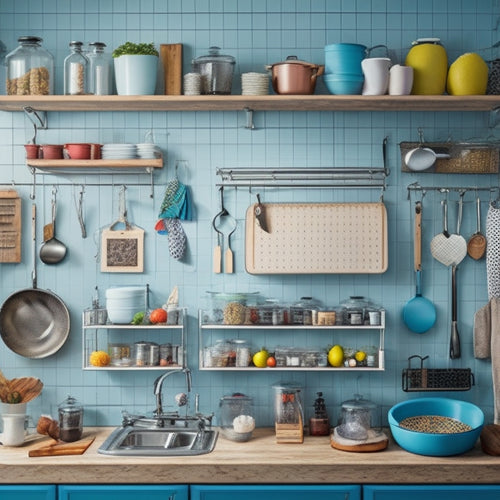
What's Holding You Back From a Gluten-Free Kitchen?
Share
You're likely holding onto habits, clutter, and inefficient systems that are preventing you from creating a fully functional gluten-free kitchen, where meal prep is a breeze and cross-contamination is a concern of the past. Cluttered countertops, poorly organized utensils, and inadequate storage solutions might be hindering your ability to prep gluten-free meals efficiently. Perhaps you're struggling to designate gluten-free zones or establish clear labeling systems, leading to mix-ups and confusion. By identifying these roadblocks, you'll be one step closer to transforming your kitchen into a gluten-free haven, where meal prep becomes a stress-free experience.
Key Takeaways
• Lack of a clear organization system for gluten-free ingredients and utensils hinders a smooth kitchen experience.
• Insufficient labeling and identification of gluten-free products and areas lead to confusion and cross-contamination.
• Inadequate storage solutions and inefficient use of kitchen space make meal prep and cleanup a challenge.
• Failure to establish separate gluten-free zones and cooking areas increases the risk of gluten exposure.
• Inadequate workflow optimization and lack of essential tools, such as dedicated cooking surfaces and utensils, slow down meal preparation.
Decluttering for a Fresh Start
To reignite your passion for cooking and create a gluten-free haven, start by purging your kitchen of unnecessary items that can harbor gluten and hinder your progress. Adopt a minimalist approach to decluttering, focusing on efficient removal of anything that's no longer serving you. Begin by sorting items into categories, such as 'keep,' 'donate,' and 'discard.' Be ruthless – if you haven't used it in the past year, it's likely taking up valuable space.
Organization tips will help you maximize your kitchen's potential. Consider a kitchen revamp, where you reassess the layout and functionality of your space. This is the perfect opportunity to create zones for specific tasks, like food prep and cooking. By streamlining your kitchen, you'll reduce visual clutter and make meal prep a breeze.
Zones for Gluten-Free Prep
As you set up your gluten-free kitchen, you'll want to create zones that guarantee safe food preparation and minimize cross-contamination.
You'll need to establish separate stations for gluten-containing ingredients and gluten-free foods, and prioritize cleanliness in these areas.
Separate Gluten Stations
Establishing separate gluten stations, or zones for gluten-free prep, is vital in a gluten-free kitchen to prevent cross-contamination. You've probably heard horror stories about gluten-free foods being compromised by gluten-containing ingredients. To avoid this, designate specific areas for gluten-free food preparation, handling, and storage. This will help minimize cross-contamination risks and ensure allergen control practices are in place.
| Gluten Station | Gluten-Free Station |
|---|---|
| Bread preparation area | Fresh fruit and vegetable prep area |
| Pasta cooking station | Gluten-free baking zone |
| Shared utensils and equipment | Designated gluten-free utensils and equipment |
Cleanliness Is Key Here
You'll find that maintaining thorough cleanliness is vital in your gluten-free zones to prevent residual gluten from contaminating your gluten-free foods. Daily cleaning and organization are important to minimize cross contamination risks. Make it a habit to wipe down countertops, sinks, and appliances after each use, and sanitize surfaces regularly.
Don't forget to clean utensils, pots, and pans thoroughly to prevent gluten residue from spreading.
Organize your gluten-free zones by categorizing and storing ingredients, condiments, and cooking essentials in designated areas. Labeling storage containers and shelves can help you quickly identify gluten-free products and avoid mistakes. Implement a 'clean as you go' policy to prevent crumbs, spills, and messes from accumulating.
Designate Gluten-Free Areas
To safeguard your gluten-free creations, designate specific zones within your kitchen where gluten-free food preparation, cooking, and storage will take place. This will help prevent cross contamination and guarantee allergen management. By separating gluten-free areas from gluten-containing areas, you can minimize the risk of accidental exposure to gluten.
Here's a suggested layout for your gluten-free zones:
| Zone | Activities | Equipment |
|---|---|---|
| Prep Zone | Chopping, measuring, mixing | Gluten-free utensils, cutting boards, bowls |
| Cooking Zone | Cooking, baking, roasting | Gluten-free pots, pans, baking sheets |
| Storage Zone | Storing gluten-free ingredients, cooked meals | Gluten-free storage containers, shelves |
Labeling for Easy Identification
By designating specific zones and labeling gluten-free ingredients, you can quickly identify what's safe to use in your kitchen. This simple step can save you time and reduce the risk of cross contamination.
Labeling gluten-free ingredients with allergen alerts, such as 'GF' or 'Gluten-Free,' helps you and others in the household quickly identify safe options. This is especially important when sharing a kitchen with others who may not have dietary restrictions.
When shopping, always read ingredient lists carefully to confirm the product meets your dietary needs. Look for certifications like the Gluten-Free Certification Organization (GFCO) or the Celiac Support Association (CSA) to ensure the product meets gluten-free standards.
Labeling and categorizing your ingredients and kitchen tools will help you maintain a safe and organized gluten-free kitchen. By doing so, you'll avoid accidental exposure and guarantee that you're always preparing safe and healthy meals.
Streamlined Storage Solutions
With a well-organized storage system, your gluten-free ingredients and kitchen tools are easily accessible, reducing clutter and the risk of cross-contamination.
A key aspect of pantry organization is an efficient layout that allows you to quickly find what you need. Consider categorizing your gluten-free staples, such as grains, baking supplies, and snacks, into separate sections or bins. This will prevent mixing with gluten-containing products and make meal prep a breeze.
When designing your kitchen, think about storage solutions that cater to your specific needs. For instance, install shelves or cabinets with adjustable compartments to accommodate different sizes of containers and equipment. You can also utilize vertical space by adding wall-mounted racks or hooks for hanging utensils, pots, and pans.
A well-planned kitchen design will help you maintain a clutter-free environment, making it easier to focus on preparing delicious gluten-free meals. By implementing these strategies, you'll be able to efficiently store and access your gluten-free essentials, ensuring a smooth cooking experience.
Simplifying Shared Kitchen Space
When you're sharing kitchen space with others, it's important to establish clear boundaries to avoid cross-contamination with gluten.
You'll want to create designated zones, label them clearly, and separate cooking areas to make sure your gluten-free space remains safe.
Designated Gluten-Free Zones
How can you secure safe cooking and minimize cross-contamination in a shared kitchen space where gluten-free and gluten-containing foods coexist? One effective strategy is to establish designated gluten-free zones. This means allocating specific areas, utensils, and equipment for gluten-free food preparation to reduce cross-contamination risks. By doing so, you can prevent gluten from spreading to gluten-free foods and avoid accidental exposure.
Family communication is key to making this system work. Discuss the importance of gluten-free zones with your household members and establish clear guidelines for food preparation and storage. This will secure everyone understands the risks of cross-contamination and takes necessary precautions.
For instance, you can designate a specific counter space or cooking station for gluten-free food preparation and label it clearly. You can also assign specific utensils and equipment, such as cutting boards and pots, for gluten-free use only. By creating these zones and communicating effectively with your family, you can enjoy a safe and stress-free gluten-free kitchen experience.
Clear Labeling and Signage
By establishing clear labels and signage, you can further simplify your shared kitchen space, making sure that gluten-free zones and equipment are easily identifiable and accessible to all household members. Labeling importance can't be overstated, as it's essential for maintaining a safe and organized kitchen environment.
When it comes to labeling, safety first is the motto. Clearly mark gluten-free zones, utensils, and storage containers to prevent cross-contamination and make sure that everyone in the household understands what's safe to use.
Signage clarity is also vital in a shared kitchen space. Easy access to gluten-free areas and equipment is pivotal, especially for those with gluten intolerance or sensitivity. By using clear and concise signage, you can direct household members to the right areas and tools, reducing the risk of mistakes and accidents.
Consider using color-coding or visual indicators to differentiate between gluten-free and non-gluten-free zones. By implementing clear labeling and signage, you can create a harmonious and safe kitchen environment that accommodates everyone's needs.
Separated Cooking Areas
In a shared kitchen space, designated gluten-free cooking areas can greatly reduce the risk of cross-contamination and make meal prep a whole lot easier for you. By separating your cooking areas, you can prevent accidental exposure to gluten and guarantee that your gluten-free meals are prepared safely. This is especially important when cooking for family members with gluten intolerance or allergies.
To create a gluten-free zone, start by designating specific countertops, utensils, and appliances for gluten-free use only. Label these areas clearly to avoid mix-ups. Consider investing in separate cooking stations, such as a gluten-free baking zone or a dedicated gluten-free cooking surface. This will help you maintain a high level of kitchen organization and prevent cross-contamination.
Essential Tools for Gluten-Free
You'll need a few specialized tools to set up a gluten-free kitchen, starting with a dedicated gluten-free cooking surface. This will prevent cross-contamination with gluten-containing foods and guarantee your safety. Next, focus on storage organization and kitchen gadgets. A separate set of cooking utensils, such as silicone spatulas and wooden spoons, will also come in handy.
Here are some essential tools to get you started:
| Tool | Purpose |
|---|---|
| Dedicated cooking surface | Prevent cross-contamination |
| Separate cooking utensils | Ensure safe food handling |
| Airtight containers | Store gluten-free ingredients safely |
| Gluten-free cookbook | Guide to new recipes and techniques |
In addition to these tools, make sure to stock your pantry with gluten-free staples, such as rice, quinoa, and gluten-free flours. Having these essentials on hand will make cooking and baking a breeze. With these tools and ingredients, you'll be well on your way to creating a safe and functional gluten-free kitchen.
Optimizing Workflow and Flow
To maximize efficiency and minimize stress in your gluten-free kitchen, designate specific zones for food preparation, cooking, and storage. This workflow optimization strategy will help you stay focused and avoid clutter.
Start by assigning a prep zone for chopping, slicing, and dicing, equipped with essential tools like a cutting board and sharp knives.
Next, create a cooking zone with your stove, oven, and cooktop, ensuring easy access to pots, pans, and utensils.
Finally, allocate a storage zone for gluten-free ingredients, cooking supplies, and equipment, using labels and bins to maintain organization.
To further enhance flow efficiency, consider kitchen design suggestions like a 'work triangle' layout, where your prep, cooking, and storage zones form the points of a triangle. This layout reduces walking distances and encourages a smooth workflow.
Additionally, install shelves, hooks, and a pegboard to keep frequently used items within easy reach. By implementing these organization tips, you'll be able to navigate your gluten-free kitchen with ease, saving time and reducing stress.
Related Posts
-

Revolutionize Your Kitchen Storage With These Ideas
You're ready to revolutionize your kitchen storage! Start by incorporating ladder-accessible shelves and utilizing cl...
-

Why Cluttered Kitchens Need Better Tool Storage
You're likely wasting around 30 minutes a day searching for misplaced kitchen tools or utensils, which is equivalent ...

